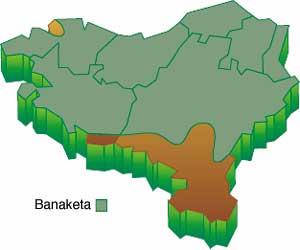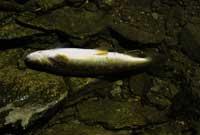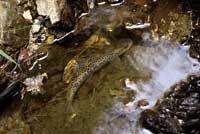River trout, queen of currents

Following my custom, today I also stretched my neck as I passed through the bridge and looked at the river of the people. As I have always seen between 6 and 8 fish and have been kept as lightning when throwing a stone into the water. Although it seems to me that there have always been between 6 and 8 trout, according to those of the previous generation, “formerly there was much more”... Trout is undoubtedly the most representative fish of the rivers and streams of Euskal Herria. It is a typical clean water animal with rocks, waterfalls and currents.
Within the species known scientifically as Psalm trutta two varieties are distinguished: the river trout ( Psalm trutta fario) and the sea trout ( Psalm trutta trutta). The only difference between the two is that sea trout is migratory, while river trout has lost that trend.
The river trout has a long and slender body perfectly adapted to the fast waters. The hard head has a wide, toothed mouth that reaches the back of the eyes. Between the head and tail can be distinguished a line of 110 to 125 scales.

As for the size of this animal, it must be said that it can be very different. In fact, the size of the trout depends on the temperature of the food, the habitat and the water it gets. Despite reaching between 15 and 20 cm in height in low races, in large reservoirs and rivers can reach between 400 g and 6-8 kg of weight, reaching a length of 60-90 cm.
The coloring is very curious. The back can be dark green, brown and gray, belly and the whole bottom, being lighter (ash or whitish). In addition, the trout is decorated with bright black and red spots, with a very striking garment.
Trout is a good swimmer. To move it contracts the strong muscles of the body and shakes the tail laterally reaching a speed of 40 km/h. Its 7 fins allow a huge control of movement in the water. These fins, with rudder, brake and balance function, allow the trout to make surprising changes of direction and speed.
This pretty fish is mainly carnivorous and can eat anything you can eat. This great triptych is on the river up waiting for any food that can bring water. It eats insects, eggs, larvae, crustaceans, worms, worms and small vertebrates, being the common cannibalism. Many times we see at the top of the water some mosquito flying. In that effort he can make perverse leaps.
In addition to the prey, the trout is prey to several animals, while the otter, with corba snake, and especially the human being are the main predators of trout. Some data to know the fishing pressure of humans are: In 1993 more than 32,000 fishing permits were granted in the rivers of Navarra and about 9,000 for Gipuzkoa. Logically, the number of catches is high and in the same year 23,000 trout were caught in the Alava mountains.
As for its distribution, it is the most common salmonid in the Northern Hemisphere and is found throughout Europe. In this respect we must remember that these are constant repopulations and that natural distribution is not very clear. As for the Basque Country, it can appear in the high and middle courses of the rivers, both on the Atlantic and Mediterranean slopes up to the Ebro River.
It needs clean, fresh (6-17 degrees) and oxygenated water to live. It seems that a minimum of 9 mg of oxygen per liter of water is needed to carry out respiration and this amount is found in rivers with temperatures below 20 degrees C. When temperatures exceed 22 degrees, trout dies, unless there are large waterfalls or abundant vegetation, which increases the concentration of oxygen in the water.
Trout has a basically night life. It is territorial and each specimen defends its territory to ensure food and hiding. They become lonely and are always close to the den if there is danger of being stored in a “breteria”.

Reproduction occurs between late October and February, although it can last until spring. They spawn the river looking for the cleanest and most oxygenated waters. Once you have searched for the appropriate place, the female will make a 20-25 cm diameter hole that hits the bottom with the belly and tail and release the eggs between the songs. At that time the male will expel the seed for fertilization. Immediately they will be covered with stones to prevent the water from being dragged.
Each female can lay between 1000 and 2000 reddish eggs of 3-5 mm per kilo of trout. After 45-60 days (depending on the temperature of the water), for the first days the offspring will be born with a yolk sac. Sexual maturity will come two years later in the case of the male and the female will need another year.
In general, it can be said that in recent years wild trout populations have declined. On the one hand, pollution is evident along the riverbed of many rivers and, on the other hand, for trout there have been canalizations, tree stems, central, disproportionate catches, etc.
On the other hand, repopulations have been made in several streams (usually fishing). This can lead to large populations of trout in normally liberated places.
With the opportunity, we would not like to run out of a happy news. Although some rivers and streams in our region are being contaminated and lost, the current situation of others is better than a few years ago. The cause has been the reduction of pollution, either by the unfortunate decline of the industry, or by the implementation of treatment plants. An example could be the Oria River, where you can now see elegant trout in Tolosa, a river that a few years ago was considered dead. See if we hear this kind of news more often!
Species: Psalm trutta |





